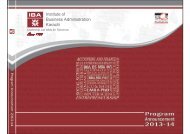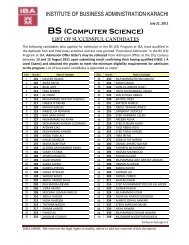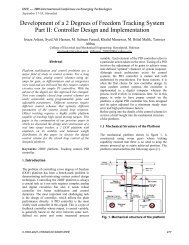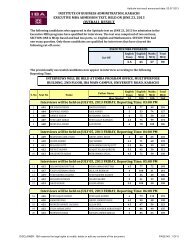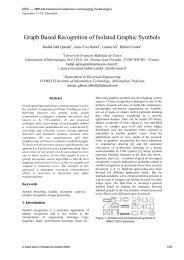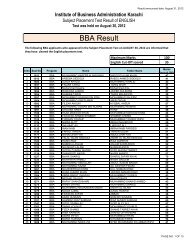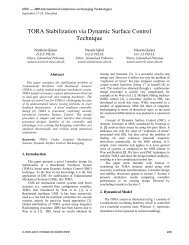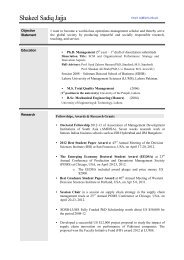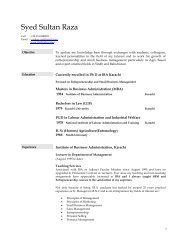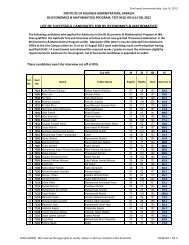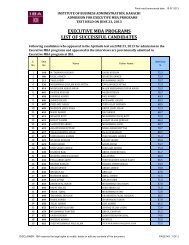Adnan Ahmed Khan, Sajid Bashir, Syed Ismail Shah
Adnan Ahmed Khan, Sajid Bashir, Syed Ismail Shah
Adnan Ahmed Khan, Sajid Bashir, Syed Ismail Shah
You also want an ePaper? Increase the reach of your titles
YUMPU automatically turns print PDFs into web optimized ePapers that Google loves.
IEEE --- 2005 International Conference on Emerging Technologies<br />
September 17-18, Islamabad<br />
<strong>Adnan</strong> <strong>Ahmed</strong> <strong>Khan</strong><br />
Centre for Advanced Studies in<br />
Engineering, Islamabad.<br />
adkhan100@gmail.com<br />
<strong>Sajid</strong> <strong>Bashir</strong><br />
Centre for Advanced Studies in<br />
Engineering, Islamabad.<br />
sajidbashir.1@gmail.com<br />
<strong>Syed</strong> <strong>Ismail</strong> <strong>Shah</strong><br />
Iqra University<br />
Islamabad Campus.<br />
syedismailshah@gmail.com<br />
Abstract<br />
Multiple Access Interference (MAI) is the most<br />
significant limiting factor on the capacity of the<br />
conventional DS-CDMA systems. In this paper an analysis<br />
of the character of MAI is carried out. The main causes of<br />
intra-cell MAI and their effects on the system are<br />
highlighted through simulation and analysis. A<br />
considerable research effort in the development of<br />
efficient Multiple User Detection (MUD) techniques is in<br />
progress, however no concrete analysis of MAI and its<br />
character modeling is found in the literature. In this paper<br />
numerous factors which result in MAI enhancement like<br />
asynchronous reverse channel, semi-orthogonal long PN<br />
codes and increase in users are analyzed. This<br />
quantification of MAI character will result in its clearer<br />
understanding and will lead to a more realistic and<br />
efficient MUD algorithms.<br />
1. Introduction<br />
Frequency spectrum is one of the most precious<br />
resources. Efforts are directed towards its efficient<br />
utilization. Spread spectrum systems serve this goal and<br />
have, therefore, received considerable attention during<br />
recent years [1]. Total capacity increase of a spread<br />
spectrum communications system can be over 10-fold in<br />
cellular mobile telephone applications compared with the<br />
narrowband frequency-division multiple-access (FDMA)<br />
systems [2].<br />
In direct sequence code division multiple access (DS-<br />
CDMA) spreading codes are used for channelization of<br />
users. When the DS-CDMA system can be guaranteed to<br />
be synchronous it is preferable to use orthogonal sequences<br />
(Walsh codes) for spreading in CDMA-2000 based<br />
systems orthogonal Walsh codes are used in the forward<br />
synchronous link. The reverse asynchronous link utilizes<br />
semi-orthogonal partial long PN codes with variable offset<br />
and spreading gain. These codes have larger cross<br />
correlation values when used in asynchronous environment<br />
where users are not time aligned [3,13]. This is really why<br />
Walsh codes are used in forward link while PN codes are<br />
used in the reverse link. In CDMA-2000 the long PN code<br />
used in reverse link has a length of 2 42 -1 = 4.4 x10 12 chips<br />
long and repeats after 41 days [4]. Each user generates its<br />
spreading code from a particular offset. The user data bits<br />
get spread with the segments of the running long PN<br />
sequence. The spreading of user bits with the PN code<br />
segments and the asynchronous channel leads to MAI in<br />
the reverse link.<br />
MAI is the interference between direct-sequence users, it<br />
limits the capacity and performance of DS-CDMA systems.<br />
The MAI caused by any one user is generally small,<br />
however with the increase in number of interferers or their<br />
powers, MAI becomes significant [13]. The knowledge of<br />
the partial-correlation properties of known PN sequences<br />
and their influence on system performance either on the bit<br />
error probability or on the signal-to-noise ratio is difficult<br />
but essential to analyze in order to mitigate MAI effects on<br />
system performance [5-12].<br />
The first section of this paper illustrates the DS-CDMA<br />
system model. Section 3 elaborates the reasons of MAI.<br />
This section also highlights the main causes such as<br />
asynchronous reverse link, non-orthogonal PN codes,<br />
larger partial cross correlation, multipath and near far<br />
effects. Section 4 aims at quantifying these effects through<br />
simulations and analysis. Results that help in the<br />
understanding and characterization of MAI structure within<br />
a cell are also presented in this section. We conclude the<br />
paper in section 5.<br />
2. System Model<br />
The system model consists of N users transmitting BPSK<br />
signals to a single receiver. The individual user data is<br />
spread using a segment of the long PN code generated with<br />
a particular offset. The data signals d 1 (t), d 2 (t) up to d n (t)<br />
include the data symbols spread by the random sequences<br />
P 1 (t), P 2 (t) up to P n (t) as shown in Figure 1. The spreading<br />
sequences are periodic extension of single periods as<br />
shown below.<br />
N<br />
∑<br />
Pi( t)<br />
= CimP(<br />
t − ( m −1)<br />
Tc)<br />
(1)<br />
M = 1<br />
Where C im is the m th chip of the spreading sequence, N is<br />
0-7803-9247-7/05/$20.00 ©2005 IEEE<br />
182
IEEE --- 2005 International Conference on Emerging Technologies<br />
September 17-18, Islamabad<br />
the spreading gain, P(t) is the chip pulse shape that is<br />
assumed to be rectangular for our simulations and Tc is the<br />
chip duration.<br />
The channel introduces delays τ to signals from different<br />
users. The signals also undergo fading before they are<br />
summed up and received by the system receiver. The<br />
received signal r(t) can be written as.<br />
r( t)<br />
= ∑ Ak(<br />
t −τ ) Pk(<br />
t −τ<br />
) dk(<br />
t −τ<br />
) + n(<br />
t)<br />
) (2)<br />
Where A k , P k and d k are the delayed amplitude,<br />
signature code waveform and data signal of the k th user<br />
respectively, n(t)<br />
is the Additive White Gaussian Noise<br />
(AWGN).<br />
and partial cross-correlation values of the spreading<br />
sequences.<br />
Partial cross-correlation values among the spreading<br />
sequences are dependent upon how much one symbol<br />
overlaps with the other symbol, which in turn depends<br />
upon the transmission instants of the individual users<br />
(which is a random) instant and their distances from the<br />
base station (channel delays). Interfering portions of two<br />
symbols from each interfering user can be thought of as<br />
just one symbol. For example, in figure 2, portions of S 21<br />
and S 22 that interfere with S 12 can be regarded as a single<br />
interfering symbol. Thus, with random spreading<br />
sequences, the asynchronous and the synchronous systems<br />
will exhibit the same average bit error rate.<br />
S11 S12 S13<br />
S21 S22 S23<br />
Figure 2. MAI for two asynchronous users. Each<br />
symbol from a user is affected by two different symbols<br />
from the other users.<br />
Figure 1. CDMA generic Reverse link model,<br />
demonstrating a typical CDMA transmitter and a<br />
channel.<br />
The spreading sequence for all the mobile users when<br />
time aligned correlate with each other to give the symbol<br />
period correlation matrix.<br />
Rij(t) = ∫ Pi(t)Pj(t)<br />
(3)<br />
Rij(t) is the element of symbol period correlation matrix<br />
in the i th row and j th column obtained by taking the inner<br />
product of the PN sequence of the i th user with that of the<br />
j th user.<br />
3.2 Effects of partial Correlation of PN Codes<br />
At present the DS-CDMA systems employ Single User<br />
Match Filter (SUMF) detection. The detection is<br />
performed by correlating a locally generated replica of the<br />
spreading sequence of the user of interest with the<br />
incoming signal, as shown in Figure 3. The correlation is<br />
performed over a symbol period and it is assumed that the<br />
symbol-long portion of the locally generated spreading<br />
sequence correlates weakly with the spreading sequences<br />
of the other users.<br />
3. MAI Reasons Analysis<br />
3.1 Effects due to Asynchronous Link<br />
The reverse link of DS-CDMA behaves asynchronously<br />
as the received symbols from different users are not<br />
aligned to a single time base [13]. In an asynchronous<br />
system, one symbol of each user is contaminated by at<br />
most two symbols of the other users. So an N-user system,<br />
there will be (N−1) interfering symbols in the synchronous<br />
case and up to 2(N−1) interfering symbols in the<br />
asynchronous case. Figure 2 shows the interfering symbols<br />
in an asynchronous system with two users. It should be<br />
noted that an increase in the number of interfering symbols<br />
from (N−1) to 2(N−1) does not imply an increase in MAI<br />
in an asynchronous system compared with the synchronous<br />
system, because the cross-correlation products are<br />
computed only over the overlapping portion of the<br />
symbols. MAI and the bit error probability in this case are<br />
dependent upon relative magnitudes of the received signals<br />
Figure 3. SUMF Receiver. A typical CDMA uplink<br />
model with distinct single user matched filters for N<br />
users.<br />
For a particular symbol, the output of the SUMF is given<br />
as<br />
∫<br />
Yi (t) = r(t)P i(t)<br />
(4)<br />
symbol period<br />
Long PN sequences are based on the statistical quasiorthogonality.<br />
Since spreading segments are distinct for<br />
183
IEEE --- 2005 International Conference on Emerging Technologies<br />
September 17-18, Islamabad<br />
each consecutive data bit, the cross-correlation value<br />
changes from bit to bit. The correlation value depends on<br />
the partial cross correlation between long sequences. The<br />
absolute maximum partial cross-correlation value between<br />
two spreading segments is occasionally larger compared<br />
with the maximum periodic cross-correlation value of short<br />
CDMA sequences. However, the partial correlation value<br />
is a random variable with distribution similar to the sum of<br />
binary independent, identically distributed (iid.) variables<br />
[20]. The cross-correlation value between two spreading<br />
segments {x} and {y} of length N can be expressed with<br />
the aid of the Hamming distance between corresponding<br />
binary code words [7,12].<br />
Cx, y = N − 2HD(<br />
x,<br />
y)<br />
(5)<br />
The absolute maximum periodic cross-correlation values<br />
for some well-known PN sequence families have been<br />
computed in [14-16]. However, the point of concern is that<br />
how the length of the long PN code segment affects the<br />
generation of MAI. It is obvious that as the number of<br />
chips in each bit is lowered according to systems spreading<br />
gain the magnitude of MAI increase correspondingly. This<br />
has been simulated and analyzed in the next section.<br />
3.3 Increasing users<br />
The effects due to increase in the number of direct<br />
sequence interfering users in understandable [6], however<br />
its quantification to characterize MAI pattern is essential.<br />
The cross correlation of each interfering users spreading<br />
sequence is amplified and added to give the resultant MAI<br />
for the reference user. Thus the increase in the number of<br />
interferers will increase MAI. The existing systems<br />
capacity can be enhanced by overcoming the MAI. In the<br />
next section we have analytically quantified the effects on<br />
MAI for a reference user with increasing systems load. The<br />
results are also confirmed through simulation in the last<br />
section.<br />
3.4 Multipath and Near far effects<br />
The power unbalance is yet another problem with DS-<br />
CDMA. If there are more than one active users, the<br />
transmitted power of the non-referenced users is<br />
suppressed by a factor dependent on the partial crosscorrelation<br />
between the code of the reference user and the<br />
code of the non-reference user. However when a nonreference<br />
user is closer to the receiver than the reference<br />
user, it is possible that the interference caused by this nonreference<br />
user has more power than the reference user.<br />
Therefore, only non-reference user will be received<br />
causing near far effect.<br />
When signals from multiple paths arrive at the receiver<br />
the fingers of rake receiver locks on to the best signals<br />
arriving through multipaths. The MAI from all the locked<br />
paths produces an additive effect. These effects on MAI<br />
due to power unbalance and multipath need to be analyzed<br />
which is done in subsequent section.<br />
4. Simulation Results Analysis and MAI<br />
Quantification<br />
4.1 Asynchronous channel<br />
The asynchronous nature of reverse link results in<br />
correlation of logically shifted PN codes, where the shift<br />
depends upon the difference between users transmission<br />
time measured in chip duration. In our simulation we have<br />
found the partial correlation of the users spreading<br />
sequences with respect to a reference user. The results<br />
shown in the figure 4 and figure 5 depict that with a fixed<br />
spreading gain (127 for simulation) for each user and<br />
keeping the PN offset an integer multiple of a reference<br />
value (255) the partial cross correlation achieves a<br />
deterministic pattern. The X-Axis shows the time<br />
difference in multiples of chip duration Tc between the<br />
transmission instants of any two users. Y-Axis shows the<br />
pattern that the partial cross correlation values will follow.<br />
The PN code with shift registers length 10, 15 and 20<br />
respectively are used.<br />
Let the PN offset be ‘K’ and spreading gain ‘S’ then the<br />
starting chip ‘C 1n ’ for the spreading code of n th user can be<br />
found by using Eq.(6) which gives the value of ‘i’ that<br />
determines ‘ Pi ’. ‘N’ is the index of user and varies from<br />
‘0’ to ‘maximum users -1’.<br />
i = (N + 1)* K where N ≥ 0<br />
(6)<br />
Long PN code is represented as.<br />
Pi = {P 1,P 2,........P k}<br />
(7)<br />
Now C 1n =P i , ‘i’ can vary from ‘1’ to ‘k’ the length of<br />
the long PN Code in chips. The length of patterns in figure<br />
5 and figure 6 is (2*S – 1) where the patterns in figure 5<br />
shows the variation of cross correlation when N ref > N async<br />
and the reference user transmission instant is before the<br />
interferer. Similarly the pattern in figure 5 shows the<br />
variations for N ref < N async and the reference user starts<br />
transmission before the interferer. The interesting<br />
observation is that this pattern remains the same for a given<br />
long PN Code, spreading gain and PN offset. Hence the<br />
max MAI which results from these cross correlation values<br />
at chip delay become deterministic.<br />
4.2 Integration over symbol period.<br />
The long PN sequences are designed to have balance,<br />
run, shift and add properties [4] which lead to a low partial<br />
cross correlation values. These properties are however lost<br />
when the length of the PN sequences are altered while<br />
selecting spreading sequences for different mobile users.<br />
The integration done in the receiver is at the symbol period<br />
Eq.(3) which includes the segment of the long PN sequence<br />
equal to the spreading gain. The autocorrelation of the<br />
spreading sequence is linearly related with its length<br />
whereas the cross correlation is a random quantity. The<br />
normalized cross correlation values for PN sequence for<br />
three different lengths is shown in figure 6. It can be<br />
inferred from the results that greater the length of PN<br />
184
September 17-18, Islamabad<br />
sequence more stable is the correlation curve, whereas with<br />
shorter PN codes the MAI behavior becomes increasingly<br />
random.<br />
The soft decision at the end of the Matched Filter is also<br />
effected by the number of chips per symbol and it moves<br />
away from the correct symbol in the constellation diagram<br />
with decrease in number of chips per symbol as observed<br />
in figure 7. It can also be deduced that the longer the<br />
spreading sequence more is the error margin available<br />
hence reducing the effects of MAI.<br />
4.3 Number of users<br />
With the increase in number of users cumulative C x,y<br />
Eq.(5) increases the variation in MAI. Figure 8 and figure<br />
9 show the designed cross correlation values for a<br />
reference user with that of other users for with spreading<br />
gain of 64 chips figure 8 and spreading gain of 128 chips<br />
figure 9. The first value being the auto-correlation of the<br />
reference user’s spreading code with itself resulting in a<br />
peak. Rests of the values are the cross-correlations with the<br />
remaining users. The difference between the autocorrelation<br />
and cross correlation is the available margin for<br />
error.<br />
It can be seen that the cross-correlation values for<br />
different users may be positive or negative which depends<br />
upon the assigned spreading codes. In case of BPSK (the<br />
modulation technique for our simulation) the data bit may<br />
only invert the cross correlation. If data bit is ‘0’ the<br />
transmitted signal is the same assigned spreading code and<br />
for data bit ‘1’ the spreading code is inverted. This<br />
inversion modulation changes the polarity of the resulting<br />
cross correlation. Assuming each user transmits data bit ‘0’<br />
the cross correlations at the receiver will be the same as<br />
that of the transmitter. In this case all those users having<br />
cross correlation in the same coordinates as the reference<br />
user will correlate constructively while the users from other<br />
half will correlate destructively. The available data for<br />
decision at the receiver is [6].<br />
Y<br />
∑<br />
= Akdk<br />
+ i,<br />
k + 1/ Tb<br />
n(<br />
t)<br />
gk(<br />
t dt<br />
k )<br />
We can re-write this equation as.<br />
Y<br />
or<br />
IEEE --- 2005 International Conference on Emerging Technologies<br />
∫<br />
ρ (8)<br />
∑dnkAndn<br />
+ ∑ dmkAmdm<br />
+<br />
= AkdK<br />
+<br />
n<br />
k (9)<br />
MAI MAI + MAI<br />
k = n m<br />
(10)<br />
Where ‘n’ users correlate constructively and ‘m’ is the<br />
total number of users which correlate destructively. The<br />
MAI to be eliminated for getting correct decision is only<br />
MAI m i.e the destructive interference. In a constellation<br />
diagram for BPSK we have a single decision boundary for<br />
the two transmitted symbols. The users with MAI n that<br />
result in constructive interference will force the estimated<br />
symbol away from the decision boundary deep into the<br />
correct decision region. Whereas the users that result in<br />
MAI m will drag the decision out of the correct decision<br />
region. The identification of users causing destructive<br />
interference will not only reduce the complexity of the<br />
MUD algorithm but will also reduce the computational<br />
overheads. Figure 8 and 9 differentiates between the users<br />
causing the two types of MAI. The worst case scenario of<br />
MAI is seen when all the users are causing destructive<br />
interference as shown in figure 10 that depicts an increase<br />
in MAI with increase in the number of users. Where as for<br />
a practical scenario when random data is transmitted by<br />
each mobile user the behavior of MAI curve is not linear as<br />
observed earlier.<br />
The algorithm shown below, if used before MUD can be<br />
helpful in deciding weather MUD is indeed required or it<br />
can be avoid, thus reducing computational complexity of<br />
the system. When the two positive and negative MAIs are<br />
equal they cancel each others effects, therefore there is no<br />
need for MUD algorithm. In the second case the MUD will<br />
only be required when the destructive interference exceeds<br />
the constructive interference by a pre decided threshold.<br />
The threshold will be selected on the basis of the channel<br />
conditions, possible maximum users and partial crosscorrelation<br />
values of the spreading sequences.<br />
If<br />
MAIn = MAIm<br />
then<br />
MAI = 0,MUD_Algorithm_not_needed<br />
elseif<br />
Abs(MAIm) − Abs(MAIn) > Threshold<br />
then<br />
Need MUD_Algorithm<br />
4.4 Multipath and Near far effects.<br />
In multipath scenario the signal from reference user is<br />
received from different paths. The rake receiver resolves<br />
these signals from different paths and presents a stronger<br />
received signal. This increased amplitude ‘A k ’ reduces the<br />
impact of MAI in having a soft decision Eq.(8). Similarly<br />
in near far effect, the amplitude variations for the<br />
interfering user ‘Ai’ and reference user ‘A k ’ also effect the<br />
soft decision. The amplitudes of the received signals from<br />
different interfering mobile users result in cumulative MAI<br />
variations which effects the soft decision for the reference<br />
user as shown in Eq.(8). The cross correlation value<br />
is scaled by the amplitude of received signal for the i th<br />
interfering user Ai as given by the following relation.<br />
k th<br />
∑<br />
MAI ,<br />
k = i kAidi<br />
ρ<br />
i, k<br />
ρ (11)<br />
ρ i, k is the cross correlation of the PN sequences of the<br />
user (reference) with the i th user (interfering). While<br />
studying the effects of MAI we may ignore noise then<br />
Eq.(8) can be written as.<br />
Y k = ρ k, kAkdk<br />
+ ρi,<br />
kAidi<br />
(12)<br />
ρ<br />
Where k, k is the autocorrelation value for the reference<br />
user which is equal to the length of the spreading sequence<br />
185
IEEE --- 2005 International Conference on Emerging Technologies<br />
September 17-18, Islamabad<br />
‘L’. The normalized correlation results in the following 7. References<br />
relation.<br />
[1] W C Y. Lee, "Overview of cellular CDMA", IEEE<br />
Y k = Akdk<br />
+ (ρi,k/L)Aidi<br />
(13) Trans.Veh. Tech., vol. V T 4 , no. 2, pp. 291-302, May 1991.<br />
In case of BPSK the data results in change of the<br />
polarity without affecting the amplitudes. The case of<br />
destructive interfering user can be written as.<br />
Y<br />
k = Ak<br />
−(ρi,k/L)Ai<br />
(14)<br />
In our simulation the threshold for decision is Y k = 0. In<br />
the above scenario when the reference user transmits bit‘0’<br />
the correct decision is for Y k > 0. The minimum amplitude<br />
for one interfering user that can results in incorrect<br />
decision is shown below, also verified in figure 11.<br />
Ai ( Ak * L) / ρi,<br />
k<br />
= (15)<br />
Figure 11 also illustrates the simulation results for<br />
multipath and near far effects. The effect on the energy<br />
available for soft decision with amplitude variations of<br />
interfering signal is also depicted. When the amplitude of<br />
the interfering user crosses certain level with reference to<br />
the user under detection the probability of correct decision<br />
minimizes. The spreading gain in our simulation is 255 and<br />
the normalized cross correlation values of the interfering<br />
users are 0.0745 and 0.0510. The curves cross the decision<br />
threshold at the minimum amplitude required for incorrect<br />
decision is evident from Eq.(15). The curve of the user<br />
with larger cross correlation has a steeper slope. This<br />
suggests that spreading sequences with smaller cross<br />
correlation values should be used in the system.<br />
5. Conclusion<br />
In this paper we have quantified the character of MAI<br />
with the aim to have a clear understanding of its behavior<br />
in an asynchronous channel. We quantified that the MAI<br />
behaves deterministically in asynchronous channel.<br />
Increase in the length of PN code segments and code itself<br />
results in a more stable MAI pattern. In addition we have<br />
showed that MUD algorithm is only required once the<br />
resultant MAI crosses a pre-defined threshold. The<br />
relationship amongst the signal amplitude and the<br />
spreading codes correlation has also been quantified. This<br />
analysis will help mitigating MAI effects and improving<br />
system capacity. These MAI parameters will also be<br />
helpful in reducing the complexity of MUD algorithms<br />
which will ultimately result in computationally efficient<br />
and fast converging MUD algorithms in DS-CDMA<br />
systems.<br />
6. Acknowledgement<br />
The authors acknowledge the enabling role of the Higher<br />
Education Commission Islamabad, Pakistan and appreciate<br />
its financial support through "Merit and Indigenous<br />
Scholarship Scheme for PhD Studies in Science and<br />
Technology ".<br />
[2] A Baier. "Multi-rate DS-CDMA: A Promising Access<br />
Technique for Third-generation Mobile Radio Systems", in Proc.<br />
PIMRC '93, Yokohama, Japan, pp. 114-118, Sept. 1993.<br />
[3] Moshavi, “Multiuser detecton in DS-CDMA<br />
communications”, IEEE communications magazine1998.<br />
[4] E. Miller, “ CDMA System engineering handbook”, Artech<br />
House mobile communications library”, 1998.<br />
[5] N E Bekir, "Bounds on the distribution of partial<br />
correlation for PN and Gold sequences", Ph.D. dissertation,<br />
University of Southern California, Los Angeles, CA, 1978.<br />
[6] N E Bekir, R A Scholtz and L R Welch, "Partialveriod<br />
correlation DroDuties of PN seauences". 4, Nov.' 1978.<br />
[7] R S Lunayach, "Performance of a Direct Sequence Spread<br />
Spectrum System with Long Period and Short Period Code<br />
Sequences", IEEE Trans. Commun., vol. COM-31, no. 3.pp.<br />
412-419, Mar. 1983.<br />
[8] D V Sarwate. M B Pursley and T Basar, "Partial<br />
Correlation Effects in Dircct-Sequence Spread-Spectrum<br />
Multiple-Access Communication Systems", IEEE Trans.<br />
Commun., vol. COM-32, no. 5, pp.567-573, May 1984.<br />
[9] P V Kumar, "The partial-period correlation moments of<br />
arbitrary binary sequences", in Proc. GLOBECOM '85, New<br />
Orleans, LA, pp. 499-503, Dec. 1985.<br />
[10] N Nazari, R Ziemer and J Liebetreu, "The effects of the<br />
code period on the performance of asynchronous direct-sequence<br />
multiple-access spread-spectrum systems", in Proc. GLOBECOM<br />
'87, Tokyo, Japan, pp. 625-629, Nov. 1987.<br />
[11] D J Tomeri, "Performance of Direct-Sequence Systems<br />
with Long Pseudonoise Sequences", IEEE Jour. On Selected<br />
Areas in Commun., vol. JSAC-10, no. 4, pp.770-781, May 1992.<br />
[12] H A Karkkainen, J Laukkanen and Hannu K. Tamanen,<br />
“Performance of an Asynchronous DS-CDMA System with<br />
Long and Short Spreading Codes - A Simulation Study”. IEEE,<br />
1994.<br />
[13] S Verd´u, Multiuser Detection, Cambridge University<br />
Press, Cambridge, UK, 1998.<br />
[14] A J Viterbi, "The Orthogonal-random Waveform<br />
Dichotomy for Digital Mobile Personal Communication", IEEE<br />
Personal Communications, vol. 1. pp. 18-24, 1994.<br />
[15] H Tarnanen and A Tietiivznen, "A Simple Method to<br />
Estimate the Maximum Nontrivial Correlation of Some Sets of<br />
Sequences", Applicable Algebra in Engineering, Communication<br />
and Computing, vol. AAECC 5, pp. 123-128.1994.<br />
[16] R S Lunayach, "Performance of a Direct Sequence Spread-<br />
Spectrum System with Long Period and Short Period Code<br />
Sequences", IEEE Trans. Commun., vol. COM-31, no. 3.pp. 412-<br />
419, Mar. 1983.<br />
186
0 20 40 60 80 100 120 140<br />
IEEE --- 2005 International Conference on Emerging Technologies<br />
September 17-18, Islamabad<br />
20<br />
'N' REFERENCE USER > 'N' ASYNCRONOUS USER SPREADING GAIN =127<br />
PN SEQUENCE LENGTH = 1023 CHIPS<br />
PN OFFSET = 255<br />
VARIATION IN PN CROSS CORRELATION<br />
10<br />
0<br />
-10<br />
-20<br />
-30<br />
30<br />
20<br />
10<br />
0<br />
-10<br />
PN SEQUENCE LENGTH = 32767 CHIPS<br />
-20<br />
0 20 40 60 80 100 120 140<br />
PN SEQUENCE LENGTH = 1048575 CHIPS<br />
20<br />
CORRELATION VALUE<br />
70<br />
60<br />
50<br />
40<br />
30<br />
20<br />
10<br />
0<br />
CORRELATION OF FIRST 64-CHIPS OVER ENTIRE LENGTH OF PN SEQ<br />
SHORT PN SEQUENCE<br />
MAX USERS = 511<br />
OFFSET = 64<br />
SPREADING GAIN = 64<br />
MAX CROSS CORR = 36<br />
0<br />
-10<br />
-20<br />
-20<br />
Variation in Cross Correlation<br />
-40<br />
0 20 40 60 80 100 120 140<br />
RELAVITIVE DELAY BETWEEN TRANSMISSIONS (MEASURED IN Tc)<br />
Figure 4. Variation of Cross Correlation when Nref>Nasync<br />
'N' Reference User < 'N' Interfering User SPREADIN GAIN = 127<br />
PN SEQUENCE LENGTH = 1023 CHIPS<br />
PN OFFSET = 255<br />
20<br />
10<br />
0<br />
-10<br />
-20<br />
-30<br />
0 20 40 60 80 100 120 140<br />
PN SEQUENCE LENGTH = 32767 CHIPS<br />
30<br />
20<br />
10<br />
0<br />
-10<br />
-20<br />
0 20 40 60 80 100 120 140<br />
PN SEQUENCE LENGTH = 1048575 CHIPS<br />
40<br />
20<br />
0<br />
-20<br />
-40<br />
0 20 40 60 80 100 120 140<br />
Overlap of Spreading in Chip Duration(Tc)<br />
Figure 5. Variation of cross correlation when Nref



